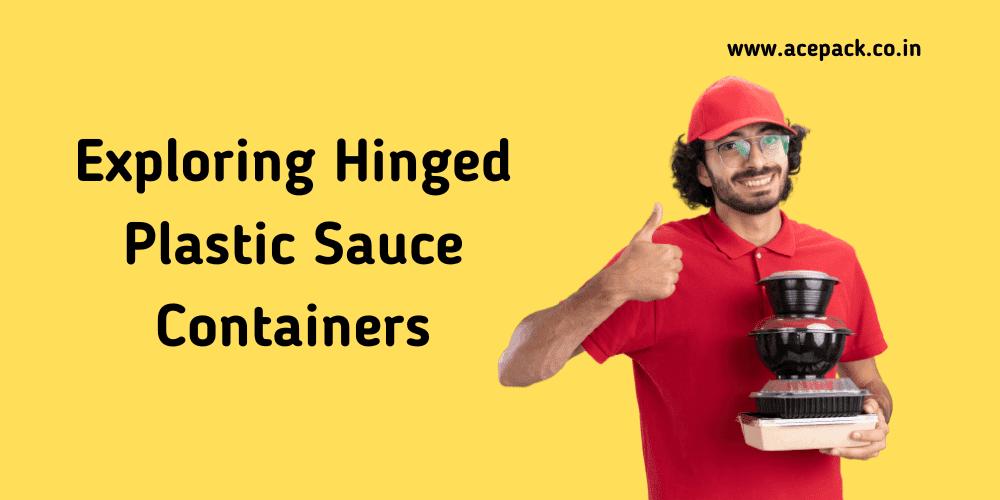
In a world where convenience and sustainability harmonize, hinged plastic sauce containers have emerged as a remarkable solution for packaging condiments. These containers offer a myriad of benefits, from eco-friendliness to reusability, all while maintaining cost-effectiveness. In this comprehensive blog post, we delve into the fascinating realm of disposable sauce packaging, exploring its environmental impact, cost-efficiency, and versatile applications. So, let's pop the lid off this delectable topic!
Table of Contents
On the culinary timeline, sauce containers have evolved from simple jars and bottles to hinged plastic containers that simplify dining experiences. Convenience, portability, and a little mess are the hallmarks of this progression. These containers not only store sauces but also transform the way we enjoy them.
Gone are the days of fumbling with flimsy sachets or leaky bottles. Hinged plastic sauce containers provide an easy-to-open design, allowing consumers to effortlessly drizzle their favorite condiments without any hassle. No more messy spills or wasted sauce—just pure culinary convenience.
The rise of hinged plastic containers showcases material innovation at its finest. These containers are crafted from a variety of plastics, each offering distinct properties that cater to different needs. From clear PET plastics for visibility to sturdier plastics for durability, these materials are the unsung heroes behind the sauce containment revolution.
In the realm of food presentation, aesthetics play a pivotal role. They provide a transparent canvas that allows the vivid colors and textures of sauces to shine through. This visual appeal not only enhances the dining experience but also presents an excellent branding opportunity for restaurants and food businesses.
Plastic often gets a bad rap due to its environmental impact. However, you can challenge this perception by being part of the solution. The key lies in proper waste management and responsible plastic usage.
The emergence of biodegradable plastics has paved the way for eco-friendly sauce packaging. These plastics break down naturally over time, reducing their long-lasting impact on the environment. By choosing biodegradable options, consumers contribute to a greener future.
Some hinged plastic containers come with FSC certification, indicating that the materials used are sourced from responsibly managed forests. This certification ensures that the production process maintains ecological balance and supports forest conservation efforts.
Calculating the carbon footprint of sauce packaging involves assessing various factors, such as production, transportation, and end-of-life disposal. Hinged plastic containers, with their lightweight design and stackability, often have a lower carbon footprint compared to traditional glass or metal containers.
Hinged plastic sauce containers are a cost-effective option, particularly when produced in bulk. Manufacturers can leverage economies of scale to reduce production costs, ultimately leading to more affordable packaging solutions for businesses.
The lightweight nature of hinged plastic containers brings a hidden cost-saving advantage: reduced transportation costs. Their lower weight translates to lower fuel consumption during shipping, benefiting both the environment and the bottom line.
Simplicity is the ultimate sophistication, and hinged plastic containers embody this philosophy. Their minimalist design optimizes space, making storage and transport efficient. This design also reduces material usage, contributing to overall cost savings.
Hinged plastic containers aren't just about sauce containment; they also aid in reducing food waste. With precise dispensing and secure closure, these containers help consumers use just the right amount of sauce, minimizing wastage and maximizing flavor.
Gone are the days of single-use packaging dominating the culinary landscape. Hinged plastic containers have redefined usability, transitioning from single-use to multi-use. This shift aligns with sustainable practices, encouraging consumers to rinse and reuse containers for various purposes.
The versatility of hinged plastic containers extends to their compatibility with microwave and freezer use. From reheating sauces to freezing homemade broths, these containers offer culinary enthusiasts the freedom to experiment without constraints.
While sauces are their primary domain, hinged plastic containers boast a world of possibilities beyond condiments. These containers are perfect for storing spices, crafting homemade beauty products, organizing small items, and even creating captivating DIY art projects.
Recycling is a crucial aspect of sustainable packaging. Hinged plastic containers often bear recycling codes that guide consumers to the appropriate recycling streams, ensuring proper waste management and reducing environmental impact.
Recyclable, hinged plastic containers go on a transformative journey after disposal. They\'re collected, sorted, and sent for recycling. The repurposed materials find new life as textiles, furniture, and even new packaging items, extending their lifecycle.
Closing the loop on plastic recycling requires collaborative efforts from manufacturers, consumers, and waste management systems. Innovative initiatives, such as take-back programs and collection drives, contribute to enhancing recycling rates and reducing plastic pollution.